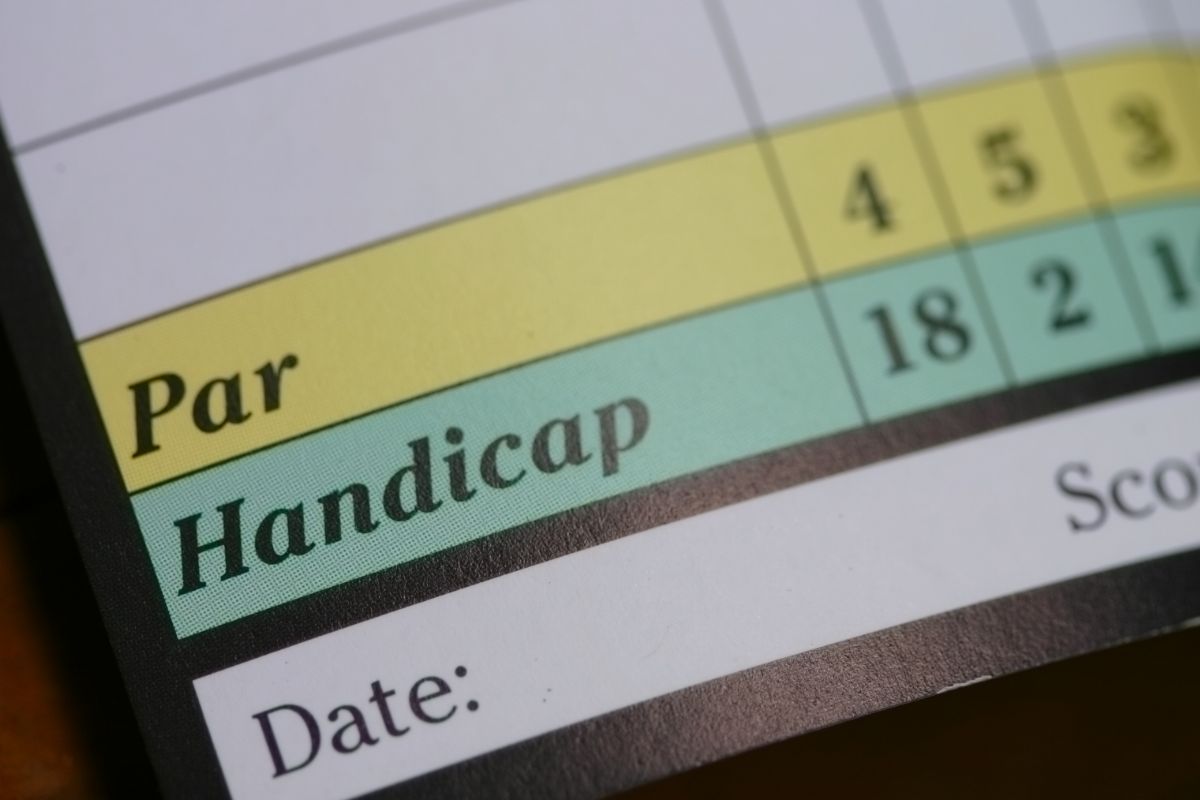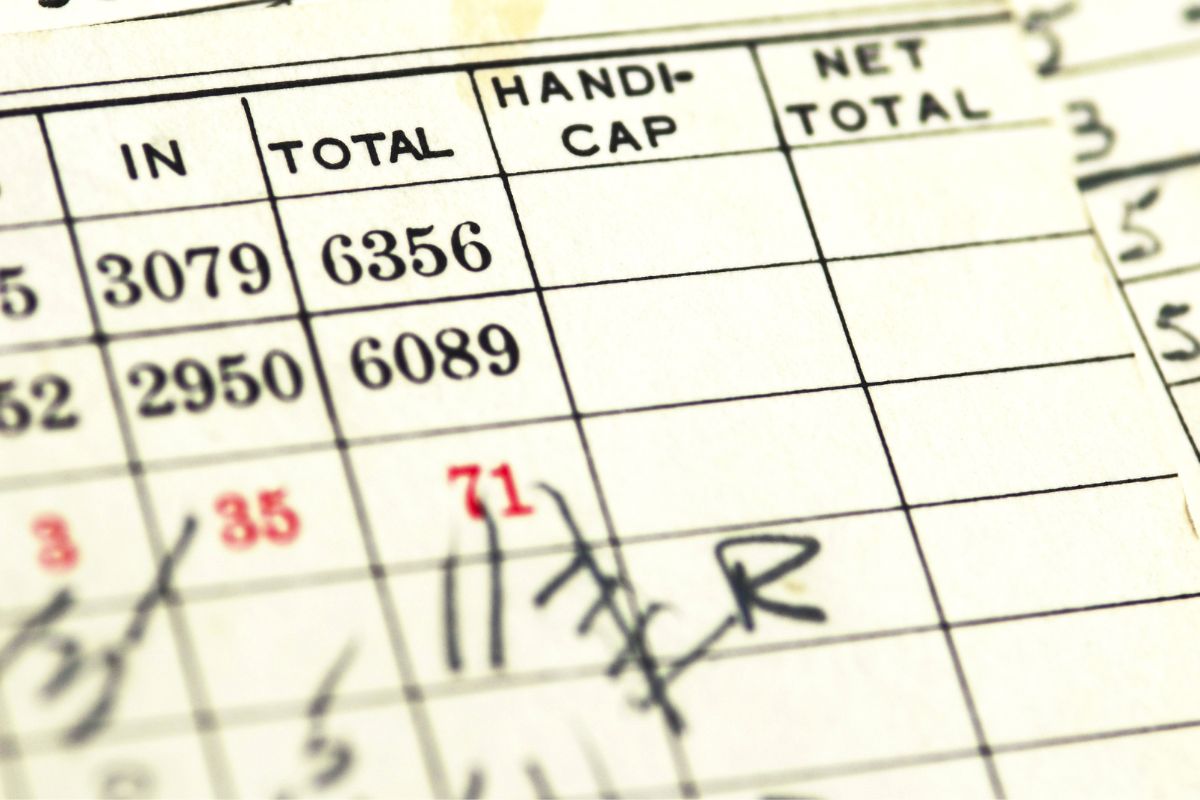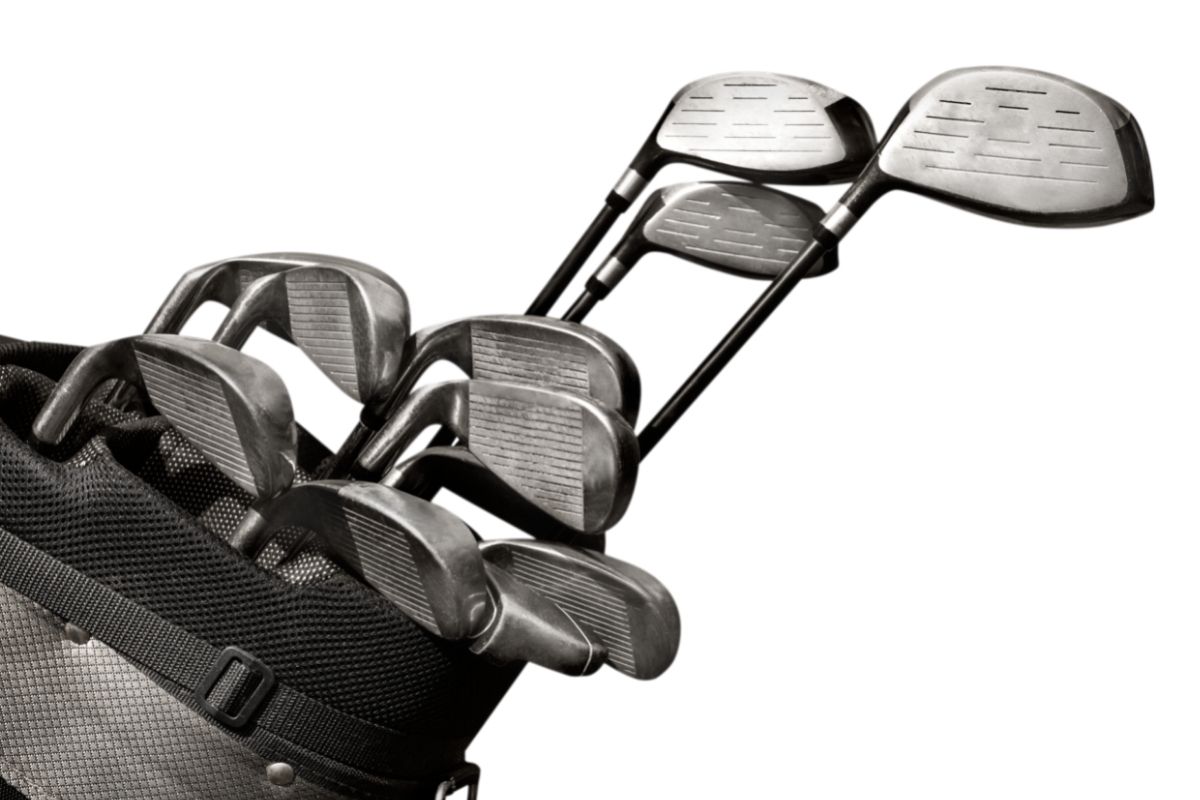We occasionally recommend products we love and might be paid a share of the sale.
There are lots of golf terms that beginners may be unfamiliar with, especially if you haven’t grown up watching or playing golf. Knowing the terms that other golfers use is important when you start to learn the game of golf.
The term handicap is widely used in golf, but what does it mean? There is a good chance that you have heard the term used before, but you might not know what it determines about a player.

This article will explain the meaning of a golf handicap and what it is used for. This is a common golf term that you should know. You can find out more about what a golf handicap means below to become more familiar with the golf handicap concept and related golf terms.
Handicap Index Course Handicap And Playing Handicap
Golf handicaps allow players of different abilities to compete fairly against one another. The course handicap and handicap index mean different things, but what is the difference between the two? And how do they relate to playing handicap?
What Is A Handicap Index?
A handicap index is determined by the official handicap system that players need to participate in golf tournaments. Using this system, ratings are produced, which then give players a specific rating number that can be taken to any golf course and translated into a course handicap. You cannot take part in most tournaments or competitions without a handicap index.
The handicap index is also a great way for players to monitor their own progress. As you improve as a golfer, your handicap index will decline. It’s also the best way to compare yourself to other players.
What Is A Course Handicap?
A golf handicap changes based on the golf course and tee boxes you are playing on any particular day. The course handicap represents the total number of strokes a player can deduct from their gross score during the round. For example, if a golfer has a course handicap of six, they will be allowed to subtract one shot from their score on the six most difficult holes.
Handicaps are used for many games played with a group of golfers. The course handicap is also used for tournaments that utilize a net score formate. Net score events enable players with a wide range of skill levels to compete on even footing. The people playing the best on that day (relative to their usual playing ability) will win the event.
What Is A Playing Handicap?
The playing handicap is closely related to the course handicap. It’s the specific application of the course handicap to a particular round of golf or a golf competition.
The playing handicap is determined by using the golfer’s course handicap and applying it to the holes of the course that they are playing that day or for a specific event.
For example, if a golfer has a course handicap of 10 and is playing a standard event, they would receive one stroke on each of the 10 toughest holes. This means that for each of those 10 most difficult holes, the golfer would be able to subtract one stroke from their score on those 10 holes.
Some tournaments will only use a fraction of the total course handicap for each participant. A common application of this method is to use 80% of the course handicap. Continuing the example above, the player with a course handicap of 10 would use a playing handicap of 8 for this event. They would still apply the eight strokes across the eight most difficult holes.
The playing handicap is usually only used in match play or stroke play competitions.
How Do You Get A Handicap Index?
You are not instantly assigned a handicap when you start playing golf. Your handicap index needs to be official, which can only be obtained from a formal golf association. American golfers must join a golf club or golf association that is an official member of the United States Golf Association (USGA). Other governing bodies, like the Royal & Ancient Golf Club, manage handicaps in different countries or regions around the world.
All private golf clubs provide handicap services to their players. If you play most of your golf rounds at a single public course, that course will be able to provide you access to the Golf Handicap Information Network (GHIN) so can begin entering scores. If you’re playing at many different courses, you can join a local golf association to get your GHIN number.
After you have joined an official USGA club, you will need to play 54 holes. Those 54 holes can be made up of either 9 hole rounds or 18 hole rounds. You will then need to post your scores from these rounds to the GHIN system. Once scores from 54 holes have been submitted, your handicap index will be generated.
How Are Golf Handicaps Calculated?
Golf handicaps are calculated after the golfer has completed all of the required rounds. After that the golf association will do the calculations and issue you a handicap index.
The official handicap index is calculated based on your most recent 20 rounds. The system calculates a score deferential for each score and averages the eight best score differentials to produce your handicap index.
Scratch golfers will have a handicap index near zero. Professional players and exceptionally good amateur golfers will have a “plus” or positive handicap index. That means the player frequently scores under par. When calculating a handicap index, 54 is the maximum handicap index that a player can have.
Related article: The Ultimate Guide To Average Golf Handicaps
Some tournaments have requirements or qualification limits that require a certain handicap to participate.
Course handicaps are calculated based on the difficulty of the course and the specific tees that are used during the round. The handicap index is applied to the course slope and rating to create a course handicap to be used for that day or event. This means that the handicap that a player is given on the course does not often equate to their handicap index.
Now you’re probably wondering, what are course and slope ratings? Let’s take a deeper look at both of those golf handicap terms.
Course Rating
The course rating is a numerical value that represents the difficulty of a golf course for a scratch golfer. The course rating is an important factor (along with the slope rating) that is used to calculate a golfer’s score differential for each round. Those score differentials are then used to calculate the handicap index and course handicap.
The course rating is set by a well trained team of evaluators who examine and measure the course’s physical characteristics and playability. The team plays the course as it is intended to be played and record their scores, the course’s difficulty, and playability. They will then use this information to assign a rating to the course that reflects the true difficulty of the course for a scratch player. The course rating is usually a number with one decimal place, such as 72.3 or 73.8.
Course ratings are calculated using a number of different factors, including the length of the course, the width of the fairways, the thickness of the rough, the size and slope of the greens, and the difficulty of the bunkers, water hazards, and other obstacles on the course. The course rating should reflect the difficulty of the course for a golfer with a zero handicap index.
Slope Rating
Slope rating is a numerical value that represents the relative difficulty of a golf course for a bogey golfer as compared to a scratch golfer. It is used in conjunction with the course rating to calculate the score differential for each round of golf. Those score differentials are then used to calculate a golfer’s handicap index and course handicap.
The slope rating of a specific course is calculated by a team evaluators who evaluate and measure the course’s physical characteristics and playability, just like the course rating. However, instead of playing the course as scratch golfer, they play it as a bogey golfer. They will record their scores and the difficulty and playability of the course to assign a slope rating that reflects the difficulty of the course for a bogey golfer. The slope rating is typically a number between 55 and 155, with 113 being the standard.
The slope rating is based on a number of variables, including the total length of the course, the width of the fairways, the difficulty of the rough, the size and slope of the putting surfaces, and the difficulty of the all obstacles found on the course. The slope rating reflects the relative challenge experienced by a scratch golfer as compared to a bogey golfer on the same golf course.
The World Handicap System
The World Handicap System (WHS) integrated 6 different handicap systems that are used all over the world. Introduced in January 2020, the WHS is now used in more than 120 nations.
Although the 6 systems are different, they all allow golfers a fair chance to play and compete. Even if they have different abilities and come from different countries, the WHS enables everyone to play together easily.
The WHS also fits with the many different golfing cultures and meets a variety of needs. It is very simple to understand, so people can successfully obtain their handicaps and play in tournaments around the world.
Accurate handicaps are important for players to have confidence in a level completion when they enter an event.
New Handicap Procedures & Scoring Adjustment Methods
The new handicap system introduced several new methods and tools for balancing the playing field. Here are a few of the most common (and controversial) new adjustment systems, calculation methods, and exception penalties used under the World Handicap System.
Adjustment Of Hole Score
The adjustment of hole scores is used to account for the relative difficulty of different holes on the course. This process was previously called “equitable stroke control,” but was changed when the World Handicap System was introduced.
Using the new handicap system, players are only allowed to enter scores that result in a net double bogey on any given hole. That means each player must calculate their own maximum score for each hole.
For a scratch golfer playing with a zero course handicap, this process is very simple. Double bogey is the maximum score on each hole. Golfers playing with an 18 course handicap also have a simple process, triple bogey is the maximum score they can enter in to the GHIN system for their handicap calculation.
For all other players, the specific hole handicap needs to be taken into account. If you are getting a stoke on a particular hole, the maximum is triple bogey. If you are not getting any strokes on that hole, the maximum is a double bogey.
This process is only used to adjust scores when entering the score in to the GHIN system for the purposes of handicap calculation. It is not used to adjust scores for a competitive round of golf or a friendly golf game with your buddies.
Playing Conditions Calculation
Playing condition calculation was added to the golf handicapping process with the introduction of the World Handicap System. Playing condition calculation is meant to account for variations in course conditions on a particular day. This is intended to more accurate reflect a players performance and the relative score differential used in the golfer’s handicap index calculation.
Course conditions can vary significantly from day to day. Factors such as weather, course maintenance, and course setup can all affect how difficult the course plays from one day to the next. Playing condition calculation is used to account for these variations and ensure that the players’s handicap index and course handicap accurately reflect their ability and can be reliably compared to other players across town or around the world.
Exceptional Score Reduction
An exceptional score adjustment is another new handicapping tool introduced with the World Handicap System. It is the process of adjusting a golfer’s handicap index after they have recorded an especially low golf score in the GHIN system. Exceptional score adjustments are meant to ensure that a golfer’s handicap index accurately reflects their current ability and prevent any unfair advantage in competitions.
Exceptional score adjustments are normally triggered if a golfer submits a score that is much lower than their usual scores. For example, a bogey golfer might get hit with an exceptional score reduction if they play a round under par. When triggered, the golfer’s handicap index is adjusted downward, resulting in the player receiving fewer strokes in handicapped competitions.
Many people object to this new handicapping rule. It’s seen by some as a double whammy and excessive penalization for a rare (or maybe just lucky) round of golf. In fact, some people believe the lowest rounds should be removed from the handicap calculation since they do not accurately reflect the golfers normal playing ability.
Penalty Scores
Penalty scores refer to extra scores that are added to a golfer’s handicap calculation to adjust from impropriety. These penalties are assessed to ensure that the golfer’s handicap index and course handicap reflect their actual play ability, and to maintain the integrity of the game.
Penalty scores can be assessed for a variety of reasons, but are primarily designed to adjust for sandbagging practices. Sandbagging is when a player intentional misses shots or records inaccurate scores in the GHIN system to artificially increase their handicap index. The higher the handicap index, the more shots granted in competition, and the easier it is to win the event.
Sandbaggers are a big problem in golf, so any action to limit or penalize sandbagging behavior is worth the effort. Penalty scores are normally assessed by the head professional at a golf course, or by the handicap committee established to monitor players handicaps at a golf club.
How Do People Improve Their Golf Handicap?

Golfers always want to improve their game, and in turn their handicap index. But how do they do it? There are several ways to improve your golf game and golf handicap.
Set Yourself Goals
Regular goal setting will help to keep you motivated. It can be very easy to give up on difficult tasks, but setting yourself achievable goals and monitoring your progress is the first step to a better handicap.
Goal setting and monitoring of progress will keep you motivated. That is important when you are trying to achieve something difficult.
Related article: What Do Good Scores Look Like For Beginner Golfers
Practice Hitting The Ball
The best way to get better at something is to practice regularly. Practicing your technique and refining your swing will help you improve your game.
You can practice hitting golf balls at a local driving range, on a golf course, or taking lessons from a professional. Having lessons from a professional allows you to learn new techniques and strategies.
If you have a busy daily schedule, you can invest in a golf simulator or practice net in your garage or basement. Ceiling height is the main factor, but many different spaces can work for a home practice facility.
Having the option to practice at home will help you dedicate more time to golf. It’s much easier to fit practice into your schedule with a home facility rather than going to the golf course or driving range everyday.
The Short Game Matters Most
Short shots first! Golf should be learned from the hole outward. The vast majority of your strokes will be putting on the green or from around the greens. To improve your scores quickly, make sure to practice your chipping and putting as much as possible.
Start with simple short putts and gradually move away from the hole. Many people enjoy hitting drivers on the range, but extra practice on the green will improve your scores more.
Choose Beginner Golf Clubs
As a beginner, you want to make sure that you are practicing at your own pace and with appropriate equipment. The wrong clubs can quickly cause you to feel frustrated, so make sure that you are using golf clubs that are suitable for a beginner.
The right clubs will enable you to feel more comfortable swinging and hitting golf shots. Over time you will be able to work yourself up to more advanced clubs.
Improve Your Stance And Power
A good way to improve your golf swing is to make sure that you are playing with the right stance and grip. Without the setup, you will hit weaker and more wayward shots.
Make sure that your feet are positioned correctly to improve your balance. More than shoulder-width apart is best to help your balance and technique when playing golf.
Wear Golf Gloves
Wearing golf gloves can help to improve your confidence on the course. You will be able to grip the club better. If you an’t get a good grip on the club, your swings will be tentative and your shots will not be accurate.
This is one simple way to improve your handicap. You will be able to swing more accurately and achieve more powerful swings. That alone will help to improve your handicap index.
Final Thoughts
A golf handicap determines how many shots a player can subtract from their gross score to generate a net score. The course handicap you use each day is derived from the formal handicap index. Course and slope rating are the key factors in that calculation. To get a handicap index, you need to join a club or association that is a member of the USGA.
There are several ways to improve your handicap index. Practicing your short game will help to improve quickly, and setting goals will keep you motivated.
Making changes to your golf stance will help you swing more powerfully. Seeking help from a teaching professional is highly recommended. Also, wearing a golf glove will improve your grip and confidence in your swing.
- Funny Golf Terms - February 21, 2023
- How To Play Vegas Golf Game - February 16, 2023
- How To Play Wolf Golf Game - February 16, 2023








